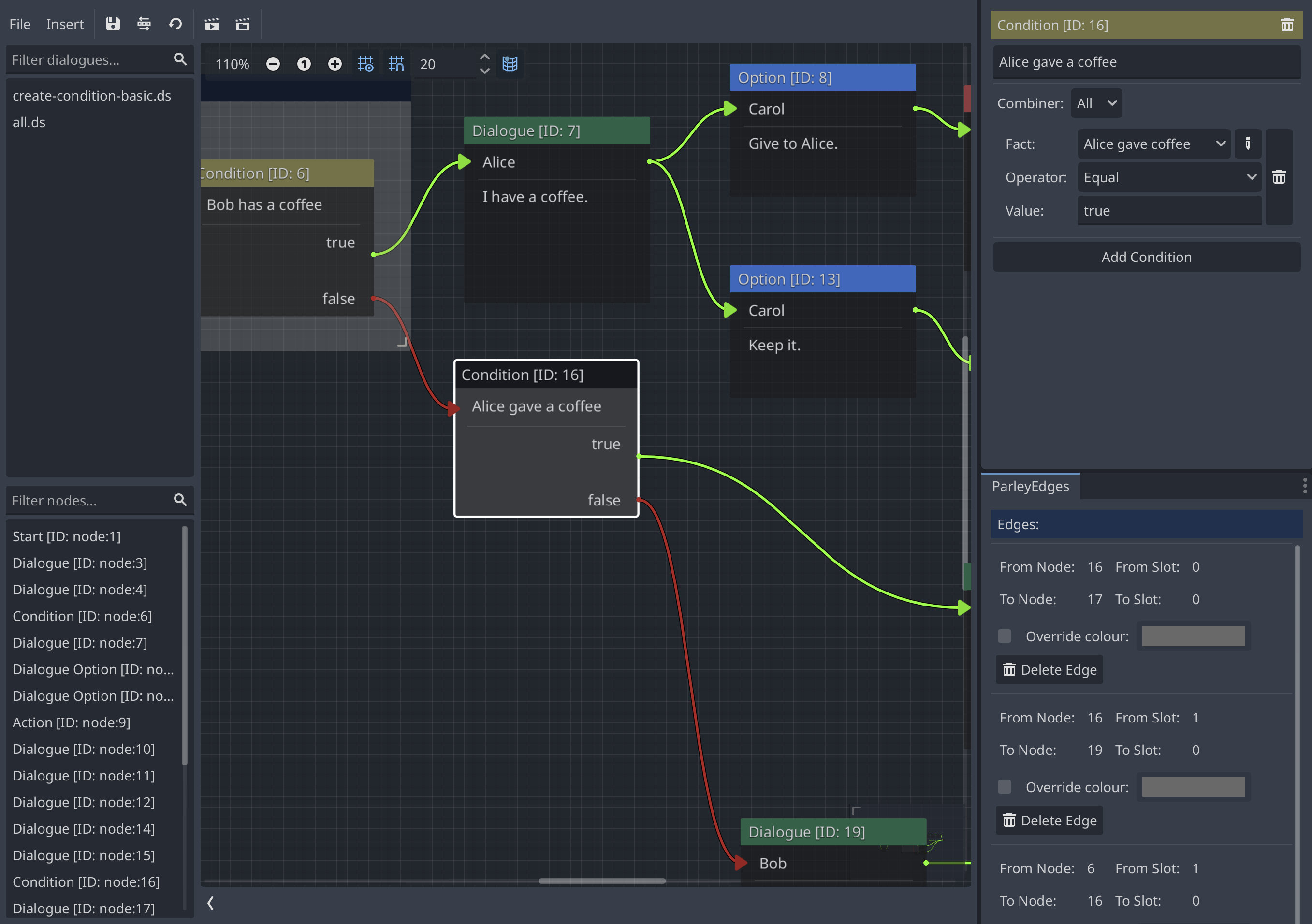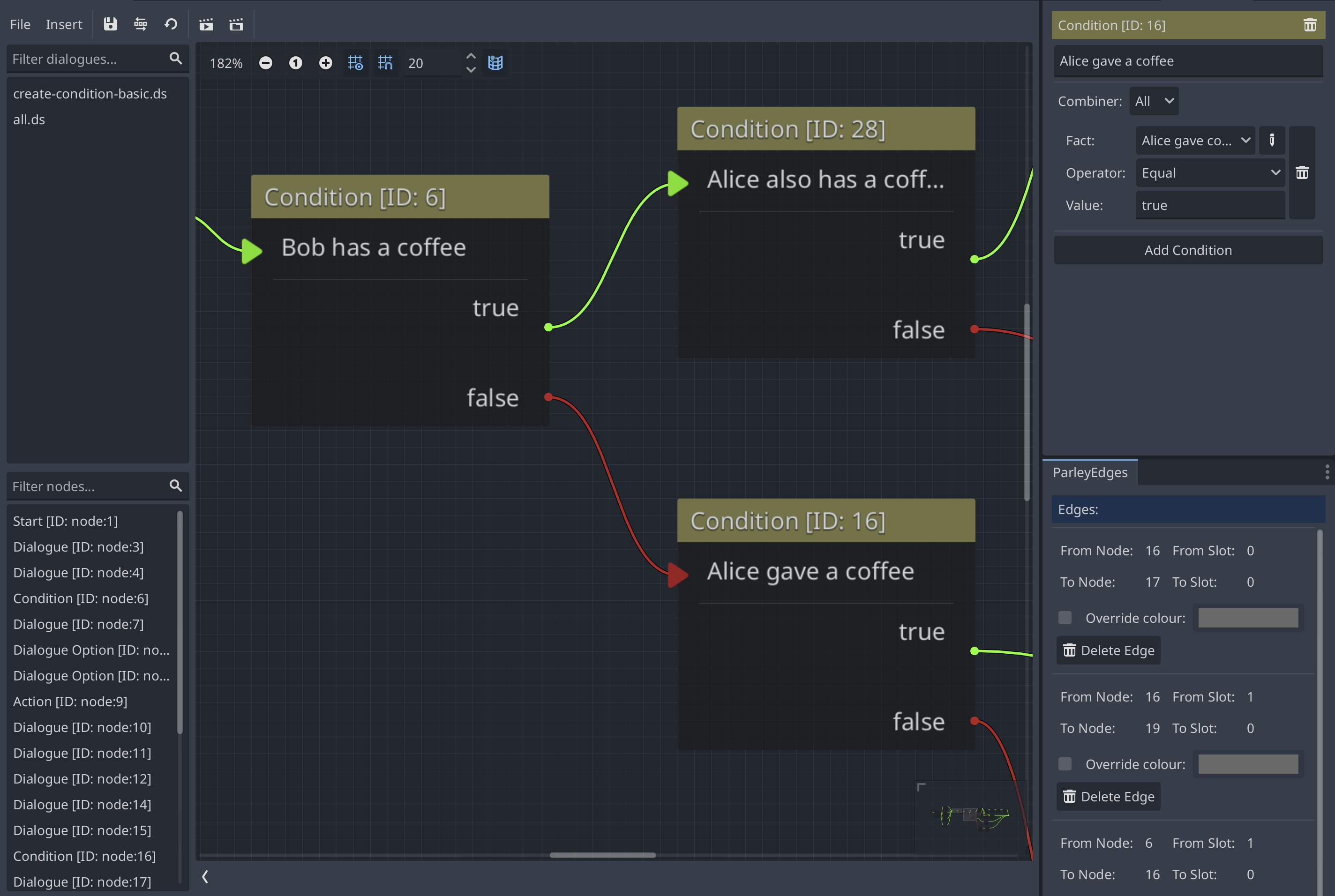Condition Node
A Condition Node is useful for selecting the next Node based on the result of a combination of conditions. They are a key part of Dialogue Sequences, allowing one to conditionally direct a player through a Dialogue Sequence graph. For example, deciding which dialogue response to render or choosing whether to render a Dialogue Option (or not).
The output of a Condition Node determines whether the check passed or not. These are:
true(green path) - the check passed.false(red path) - the check failed.

They have the following characteristics:
Description
A human-readable description of the Condition Node to aid future understanding of the Node at a quick glance.
Combiner
The Combiner determines whether the combination of conditions pass the overall condition check or not. At the moment, Parley supports the following Combiners:
ALL- All of the defined conditions must pass for the Condition Node check to pass (a.k.a returntrue(green path)).ANY- Any one of the defined conditions must pass for the Condition Node check to pass (a.k.a returntrue(green path)). If some fail, the check will still pass provided that one of the conditions has passed.
Conditions
The conditions to evaluate for the Condition Node. Each condition contains a Fact that is compared and they are evaluated and used in conjunction with the Combiner to determine whether a Condition Node check has passed or not. See the scenarios for some examples.
Each condition has the following characteristics:
Fact Ref
The Fact to evaluate for the Condition Node. These are stored in the Fact Store and at runtime are evaluated for comparison using the defined Operator and value.
You can think of a Fact as something that is exactly what it says on the tin, a
Fact. For example, a Fact could be: Alice gave a coffee. This Fact represents
whether Alice gave a coffee or not. If this Fact evaluated to true during the
running of Parley, then we can say: Alice did indeed give a coffee. However, if
the Fact evaluated to false, then we can say: Alice did not give a coffee.
To find out how to define and register a Fact, please follow the guide here.
Operator
As its name suggests, the Operator used to compare the result of a Fact against the defined value. The following Operators are supported:
EQUAL- whether the Fact equals the valueNOT_EQUAL- whether the Fact does not equal the value
Value
The value to compare against the output of the Fact using the Operator above.
TipThe value will be coerced to match the output type of the evaluated Fact where possible. For example, if the Fact evaluates to an integer: 2, a value of
3will be coerced to an integer of3for comparison.
Scenarios
Below is a list of common scenarios to help you understand how Condition Nodes work.
Scenario 1
Let’s say the Condition Node is defined as follows:
Combiner: ALL
Conditions:
- Condition 1:
- Fact:
alice_gave_coffee - Operator:
EQUAL - Value:
true
- Fact:
When the Fact alice_gave_coffee evaluates to true
The Condition Node evaluates to true and the Dialogue Sequence continues down
the true (green) path only.
Scenario 2
Let’s say the Condition Node is defined as follows:
Combiner: ALL
Conditions:
- Condition 1:
- Fact:
alice_gave_coffee - Operator:
EQUAL - Value:
true
- Fact:
When the Fact alice_gave_coffee evaluates to false
The Condition Node evaluates to false and the Dialogue Sequence continues down
the false (red) path only.
Scenario 3
Let’s say the Condition Node is defined as follows:
Combiner: ALL
Conditions:
- Condition 1:
- Fact:
alice_gave_coffee - Operator:
EQUAL - Value:
true
- Fact:
- Condition 2:
- Fact:
bob_has_coffee - Operator:
EQUAL - Value:
true
- Fact:
When the Fact alice_gave_coffee evaluates to true and the Fact
bob_has_coffee evaluates to true
The Condition Node evaluates to true and the Dialogue Sequence continues down
the true (green) path only.
Scenario 4
Let’s say the Condition Node is defined as follows:
Combiner: ALL
Conditions:
- Condition 1:
- Fact:
alice_gave_coffee - Operator:
EQUAL - Value:
true
- Fact:
- Condition 2:
- Fact:
bob_has_coffee - Operator:
EQUAL - Value:
true
- Fact:
When the Fact alice_gave_coffee evaluates to true and the Fact
bob_has_coffee evaluates to false
The Condition Node evaluates to false and the Dialogue Sequence continues down
the false (red) path only.
Scenario 5
Let’s say the Condition Node is defined as follows:
Combiner: ANY
Conditions:
- Condition 1:
- Fact:
alice_gave_coffee - Operator:
EQUAL - Value:
true
- Fact:
- Condition 2:
- Fact:
bob_has_coffee - Operator:
EQUAL - Value:
true
- Fact:
When the Fact alice_gave_coffee evaluates to true and the Fact
bob_has_coffee evaluates to true
The Condition Node evaluates to true and the Dialogue Sequence continues down
the true (green) path only.
Scenario 6
Let’s say the Condition Node is defined as follows:
Combiner: ANY
Conditions:
- Condition 1:
- Fact:
alice_gave_coffee - Operator:
EQUAL - Value:
true
- Fact:
- Condition 2:
- Fact:
bob_has_coffee - Operator:
EQUAL - Value:
true
- Fact:
When the Fact alice_gave_coffee evaluates to true and the Fact
bob_has_coffee evaluates to false
The Condition Node evaluates to true and the Dialogue Sequence continues down
the true (green) path only. (Note the ANY Combiner here).
Scenario 7
Let’s say the Condition Node is defined as follows:
Combiner: ALL
Conditions:
- Condition 1:
- Fact:
alice_hit_points - Operator:
EQUAL - Value:
0
- Fact:
When the Fact alice_hit_points evaluates to 1
The Condition Node evaluates to false and the Dialogue Sequence continues down
the false (red) path only.
Scenario 8
Let’s say the Condition Node is defined as follows:
Combiner: ALL
Conditions:
- Condition 1:
- Fact:
alice_hit_points - Operator:
NOT_EQUAL - Value:
0
- Fact:
When the Fact alice_hit_points evaluates to 1
The Condition Node evaluates to true and the Dialogue Sequence continues down
the true (green) path only.
Advanced usage
Nesting Condition Nodes
In more complex conditional cases, one may want to nest a series of conditions. To achieve this in Parley, you can nest the Condition Nodes together by connecting the output edges to the input of the nested Condition Nodes. For example:
